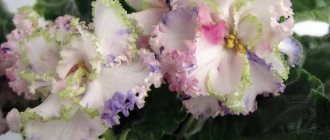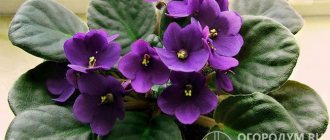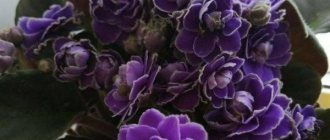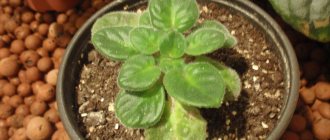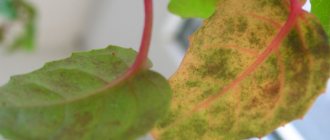general description
Winter cherry
Frost
Cherry Violets are perennial plants with petiolate leaves. Violet flowers come in a variety of colors and are single. The leaves of the plant have the shape of a heart, the stem is creeping. The fruit is presented as a capsule with valves.
Breeders do not stop developing more and more new species and varieties of violets, and therefore making a choice is becoming more and more difficult.
Plants that are inconspicuous at first glance are capable of turning even the smallest windowsill into a stunningly beautiful flower bed during their flowering.
Among the variety of varieties, the varieties of violets “Cherry” stand out for their elegance, namely “Frosty Cherry” and “Winter Cherry”.
A distinctive feature of violets of the “Frosty Cherry” and “Winter Cherry” varieties is that they have a breathtaking dark cherry color with a white border along the edges of the petals.
This is very reminiscent of bright red cherries in the snow, dusted with frost, which gives the varieties their name.
Useful properties and uses of violets
This indoor plant not only pleases household members with its beautiful flowering. Violet is actively used in folk medicine. It has anti-inflammatory, laxative and diuretic effects. Violet herb helps with bronchitis, sore throat, whooping cough, headaches, migraines. A decoction based on violet herb can be used for external and internal use. An infusion of violet flowers is used for convulsions, epilepsy, and tinnitus.
Popular folk recipes from violet leaves and flowers:
- For sore throat. Pour 50 g of plant flowers into 200 ml of alcohol. Close the lid and leave to infuse for 7 days. The prepared tincture is taken 30 ml before meals 3 times a day. To achieve an effective result, you can gargle with this tincture.
- When coughing. Take dried violet leaves and flowers in equal quantities, about 50 g. Next, pour a glass of hot water and leave to steep for a day. Then strain, heat slightly over low heat and sweeten. Take a teaspoon 4 times a day. The duration of treatment is about 7 days.
- For insomnia. Take 3-4 grams of flowers and pour boiled milk (200 ml). Leave in this state for 30 minutes. The prepared composition should be drunk before bed and the flowers should be eaten.
It is recommended to add violet decoction to bathing water for babies. With regular use, it helps cure rickets, eczema, scrofula and skin rashes. When using violet to treat various diseases, remember that the plant is poisonous. It is recommended to consult a doctor before using decoctions and infusions based on violet leaves and flowers.
Video about the flowering of the violet “Frosty Cherry”:
If you place a blooming Saintpaulia of this variety in an area with less light, then the petals of the violet variety Winter Cherry will begin to lighten. Indoor flowers of the Frost Cherry species prefer warm climates, because their ancestors come from West Africa, but do not tolerate high temperatures combined with high humidity. In the cold, the intensity of the shade becomes weaker.
If the temperature outside the window is low, white color predominates in the flowers, and in the heat red dominates, to the point that the white areas on the petals of Saintpaulia may completely disappear. The flowers of this variety are large in size, but this feature is noticeable from the second and subsequent blooms. It may seem that plants of this variety bloom better when lit by a candle, but this is most likely a subjective feeling.
As for the leaves, in young plants they are a little lighter than in mature Saintpaulias. It should be noted that at various exhibitions of indoor flowers, violets of the Frosty cherry variety are always popular among visitors because of their bright and rich color.
Origin story
Frosty Cherry
The charming variety “Frosty Cherry” appeared thanks to the hard work of the Russian breeder Konstantin Morev in 2005. 11 years of work culminated in the creation of an extraordinary plant with perfect flowers.
Flowers of various rich cherry shades, with bright strokes or as if covered with frost, look equally magical.
The most interesting variety “Winter Cherry” was also created by Russian breeder Elena Korshunova in 2006. This is a talented specialist with many successful works behind him.
Both varieties of “Cherry” are among the young, extremely popular due to their colorful, very effective combinations of cherry and white flowers.
Appearance: description
Frosty cherry
“Frosty cherry” is a violet that has large double flowers about 4 cm. The color range is represented by both crimson and pale pink shades.
The petal presents a color transition, from a rich cherry red in the center to a soft white stripe along the edge.
An impressive characteristic of the gardener is the ability of a flower to change color with changes in temperature in the environment.
The flowers turn dark cherry red at high temperatures and lighten as the temperature drops.
And also, depending on the time of flowering, the stability of lighting, the saturation also changes. The rosette of the plant has a standard appearance and size, represented by simple pointed leaves.
Long-lasting, up to 10 months, and abundant flowering makes the plant one of the favorites of gardeners. The number of flower stalks can be increased with the help of special fertilizers. Biological rest is extremely useful.
The appearance of darkening petals, as a rule, indicates the aging of the plant.
Violet "Winter Cherry" has huge, semi-double flowers to the touch, with wavy edges. The petals in the center are thick cherry, almost black in color, and seem to be frosted along the edges. This variety is also characterized by a change in color with changes in temperature.
Darkening of the flower in two-color violets
Flower growers have to deal with darkening when growing two-color Saintpaulias. What affects:
- Plant aging;
- Increased soil acidity;
- And the temperature rises.
This can happen with the same variety. If you place it in the apartment in different places. Where the conditions are even slightly different (window sill rack, winter-summer, first or second flowering).
Other deviations from the main color of the flower are also possible:
- Disappearance of spots and streaks;
- The color becomes neutral (mixed).
Important! It is very rare for sports to return to their previous colors. And the darkening passes.
Care
Frosty cherry
The health and appearance of violets depend on the grower’s ability to provide their needs for watering, lighting and nutrition. Under optimal conditions, violets bloom for nine months of the year.
Temperature
The violet can tolerate short-term temperature drops of up to 12 °C, but it needs warmth for normal development.
The plant feels comfortable if the thermometer shows 20-22 degrees Celsius.
Sharp temperature fluctuations are contraindicated for the flower.
Lighting
Winter cherry
Windows with eastern or western orientation are most suitable for placing violets. To get an even rosette, the flower is periodically turned. If Saintpaulia is placed far from the window, it is provided with additional lighting.
Important! Correctly selected lighting is the key to abundant flowering of violets. With a lack of lighting, leaf cuttings stretch and rise, and the color of leaves and flowers loses saturation and brightness.
Direct sunlight can cause burns on the leaves, so the plant should be shaded from excessively bright light.
Watering
You can provide violets with moisture in different ways: use wick watering, water in a tray or from above.
Wick watering will help the gardener save time. In this case, a string is placed in the pot, passing it through the drainage hole.
The part of the wick that comes out is lowered into a container of water. When using the “bottom watering” method, water is poured into the pan for 20 minutes, then the excess is drained.
Most often, this method is used in greenhouses for the mass cultivation of Saintpaulias, but it can also be used in indoor floriculture.
Most often, ordinary people water homemade violets from above, carefully moistening the earthen ball.
In this case, it is necessary to follow certain rules: Water if the surface of the soil in the flower pot is dry. At different times of the year, the frequency of watering differs. In winter, you can moisten the plant 2-3 times a week, and in summer this procedure is carried out daily.
It is advisable to use settled water at room temperature.
Moisten the plant evenly, trying not to create stagnation of moisture and not leave dry areas. Excess water is drained from the pan after a quarter of an hour.
Humidity
The most suitable humidity for growing Saintpaulias is 50%. In a drier atmosphere, the flowers will be slightly smaller and the leaves denser.
The critical time for Frosty and Winter cherries is the heating season, especially if the flower is located near radiators. Streams of hot air negatively affect the plant, its leaves begin to turn yellow.
Attention! Violets, like other flowers with pubescent leaves, do not like spraying. Therefore, when growing these flowers, other methods of increasing humidity are used.
To humidify the air, plants are placed in a tray with damp expanded clay or moss, or containers filled with water are placed next to the pots.
The presence of a humidifier or air washer in the apartment completely removes the problem of achieving the required humidity.
Priming
The delicate roots of violets are very sensitive to soil. Therefore, when choosing a substrate, you need to remember that it must be loose and nutritious.
When preparing a soil mixture, violet growers often use peat and agroperlite with the addition of crushed moss. Peat (or light garden soil) is a filler.
Perlite (like vermiculite, sphagnum, sand) acts as a leavening agent, providing good moisture retention and breathability. You can also add nutritious compost soil or humus.
As for the exact proportions, there are many recipes. For example, in the book of the famous breeder Boris Mikhailovich Makuni there is such a description: high-fiber coarse-fiber peat - 2 parts, sphagnum moss and turf soil - one part each, river sand - 0.5.
Attention! When independently preparing soil for violets, it must be sterilized.
To do this, you can spill the soil with boiling water or a strong solution of potassium permanganate. Sometimes the soil mixture is frozen, which also helps get rid of harmful insects.
Flower growers who do not have a lot of time use commercially sterilized components or ready-made mixtures for Saintpaulias.
Feeding
Violet cherry, like other plants that are in a limited volume of substrate, needs regular feeding.
However, it should be noted that too concentrated solutions are harmful to plants. Violets tolerate a lack of fertilizer better than an excess. For Saintpaulia, the optimal solution is considered to be a solution in a concentration of 1 g of complex mineral salts per 1 liter of water.
This feeding is carried out once every 2-3 weeks. In addition, excess potassium leads to stunting of growth, and excess nitrogen, on the contrary, promotes the growth of green mass to the detriment of flowering.
Therefore, nitrogen fertilizers are suitable for children, and phosphorus fertilizers are chosen for plants with buds.
Typically, complex fertilizers with a low nitrogen content are used for violets.
It is useful to alternate mineral and organic fertilizers. After transplanting into fresh soil, no fertilizer is applied for two weeks.
During the dormant period, the plant is also not fertilized.
For reference! Peters fertilizers give good results. This manufacturer offers different formulas for the flowering and growth of violets.
The use of Osmocote long-acting fertilizers saves time and gives a visible effect. The granules are placed in a pot during transplantation and over several months, under the influence of water, microelements are released and nourish the plants.
When and how does it bloom
According to the description, if the growing conditions are met, the Blue dragon violet blooms for a long time and luxuriantly. This variety belongs to the bouquet category. A head of flowers forms in the center of the rosette, completely covering its middle.
Types of flowers
The Blue Dragon variety has semi-double and double flowers. They are bright blue in color with a blue eye in the center and lilac edging. The edges of the petals are corrugated and painted light green.
Important! The lilac border on the flowers appears only when kept cool; if the temperature rises, it disappears
Flower shapes
A distinctive feature of the Blue Dragon are large bright flowers that resemble a star in appearance. Their diameter reaches 7-8 cm, and in some cases even 10 cm.
Peduncles are strong and can easily withstand loads. Each of them produces from 3 to 5 buds.
An adult rosette can form up to 50 flowers simultaneously
Flowering period
If the basic care requirements are met, Saintpaulia of this variety can bloom continuously throughout the year.
With a lack of light in the autumn-winter period, the plant grows foliage. In this case, flowering begins with the arrival of spring and continues until the end of summer.
Changes in care during the flowering period
During the formation of buds, the Blue Dragon variety must be kept cool. In this mode, a bright lilac border appears on the petals, which is typical for this species. The soil should not be allowed to dry out, as this will cause the flowers to wither.
Bloom
Violet winter cherry
Not greedy for flowering, the Winter and Frosty cherry varieties delight with beautiful flowers almost all year round. In winter, it is recommended to create a dormant period for a couple of months, reduce watering and not add additional light.
After this, you need to create favorable conditions for growth - and soon an elegant bouquet will be formed. Peduncles appear in the axils of the leaves, each bearing several flowers. Mature plants are prone to cap flowering.
To extend the flowering time, do not forget a few simple rules:
- It is important to provide the violet with good lighting. With a lack of light, the flowers fade, and the leaves and peduncles become elongated.
- Wilted flower stalks need to be removed.
- For flowering plants, the daylight hours should be 12 hours.
- During budding and flowering, violets need fertilizing and frequent watering.
When and how does it bloom
With proper care, violets can bloom 10 months a year. The rosette begins to grow at 11 months.
This is an amazing plant, the shades of its flowers depend on the temperature. If you want to get a delicate, almost white inflorescence with a slight blue, the plant should be kept at a temperature no higher than 20 degrees. The warmer the room, the darker the violet blooms.
Inflorescence shapes
The plant always blooms with a large head. The emergence of buds is directed towards the center; they are supported on strong peduncles.
The Blue Fog variety is popular due to the fact that its flowering can be enjoyed for a long time. It happens in waves. Each bud lasts a long time.
Changes in care during the flowering period
If the violet blooms for a long time, it is necessary to improve the conditions for its maintenance.
It is important to provide good lighting at least 12 hours a day
The soil needs to be additionally fertilized, since flowering reduces the plant’s immunity.
Dried parts that have faded must be carefully removed.
Growing
Landing
To plant an adult plant, it is advisable to use a pot that is not too deep and without drainage. The soil should be light and loose, and therefore the soil composition is: 3 parts - peat, 1 part - baking powder and 1 part - Vermion soil.
When planting violets with seeds, there is no guarantee that the flower will inherit all the maternal characteristics.
Mixes and pots
You can take a special mixture for violets or a mixture of coniferous, turf and leaf soil, add a little peat and baking powder.
The described varieties of violets do not like deep, large pots, since their roots are located in the top layer of soil. For convenience, it is better to use low dishes.
How to grow properly
A purchased adult plant must be replanted in a permanent pot. To do this, we use soil, which must include peat and baking powder.
The soil should be light and loose; violets do not like anything else. A mixture of turf, peat, leaf and coniferous soil with the addition of baking powder is suitable.
If you want to plant a violet cutting, you need to:
- In the washed sheet, cut off all excess, leaving only 2 cm;
- It is better to plant in a plastic cup with lower holes;
- A sheet is installed in the prepared poor soil;
- Insulate the glass, creating a prototype of a greenhouse.
In the first days, a lot of light is not required. Roots begin to appear within 3-4 weeks after planting. In a month you can already see the first leaves. The planted leaf can be removed after 3-4 months.
Large pots are not for violets, since their roots do not penetrate deep, but are located on the surface. The plant also does not require drainage.
Expert opinion
Yulia Yurievna
I have a large garden and vegetable garden, several greenhouses. I love modern methods of cultivating plants and mulching the soil, and I share my experience.
Ask a Question
We do not recommend replanting the Winter Cherry violet immediately after purchase. The flower must get used to the new microclimate, otherwise adaptation and the simultaneous change of the usual soil and container can become too much stress. Exceptions are cases when signs of disease or the presence of pests are noticed on the purchased specimen. Then, it is better to replace the substrate, as it can be a source of infection. The soil should be loose, but nutritious and not too light. Otherwise, the soil will dry out quickly, which will negatively affect the root system. For example, applying fertilizer can burn the rhizome due to too rapid evaporation of moisture. If you decide to root a violet cutting, the cut should be made at an acute angle, so the area for root formation will be larger and the nutrition will be better. When the cut is made, it is better to let the cutting dry for 15-20 minutes. For quick rooting, you can use a stimulator. To protect a young plant from diseases, it is important to thoroughly disinfect the selected substrate, for example, by frying it in the oven or pouring boiling water on it. A fungicidal solution can be used. It is also better not to use large pots, as this can cause rotting of the root system. The roots will not be able to absorb all the moisture received and stagnation will form. This is especially true if you use top watering under the edge of the pot.
Nuances of propagation and transplantation
Frosty cherry
Seed propagation of violets is a very labor-intensive process. The flower is pollinated, the seed pod is waited for to ripen, and tiny seeds are sown in the greenhouse. You will have to wait at least a year for flowering, and the result is unpredictable.
Seedlings can repeat the flowering of their parents, but flowers often appear that differ in both color and size. Interesting! According to esotericists, violet is a plant of Taurus and has energy that brings material well-being.
The most common method of propagation is from leaf cuttings.
Propagation by cuttings
A healthy large leaf is cut with a clean knife and placed in a glass of water or directly into the ground. It is recommended to cover the sheet with a bag or jar.
When the emerging babies reach 1/3 of the mother leaf in size, they are planted in separate pots. Such plants retain all varietal characteristics and bloom for 8-9 months from the moment of rooting.
If the Saintpaulia roots have filled the pot, it is transplanted into a container with a slightly larger diameter.
Adult plants are replanted once a year, young plants - every 3 months. Violets love fresh substrate and respond to replanting with active growth or budding.
Diseases and pests
Frosty cherry
Unfortunately, plants can also get sick. The use of new pots and new soil when planting is a measure to prevent the appearance and development of diseases.
Plant diseases and their probable causes:
- The presence of holes and yellow spots on the leaves means excessively bright light.
- Leaves turning pale, curled edges – cold.
- Rotting roots - excessive watering with cold water.
- Falling inflorescences mean too much fertilizer.
The most common pests are cyclamen mites and thrips. The tick is not visible to the naked eye. It settles at the growth point, as a result the center of the rosette is deformed and covered with gray fluff. Flowers wither and leaves become brittle.
To combat ticks, use Actellik or Nissoran. Thrips are small, rapidly reproducing insects. Signs of damage by this pest are spots, plaque and holes on the leaf blades. They get rid of thrips with the help of the drugs “Akarin” and “Confidor”.
How Saintpaulia Frosty Cherry Moreva propagates
Violet Duchess - description and characteristics of the variety
All Saintpaulias are easily propagated vegetatively: by leaves and even a segment of the leaf blade, peduncles, and also by children formed at the roots. Rooting of leaves and peduncles can be done in water or substrate. Root formation occurs on average in 4-6 weeks. But the flowers of daughter plants do not always repeat the parental color; in such cases, breeders talk about getting a sport.
Rooted leaves

